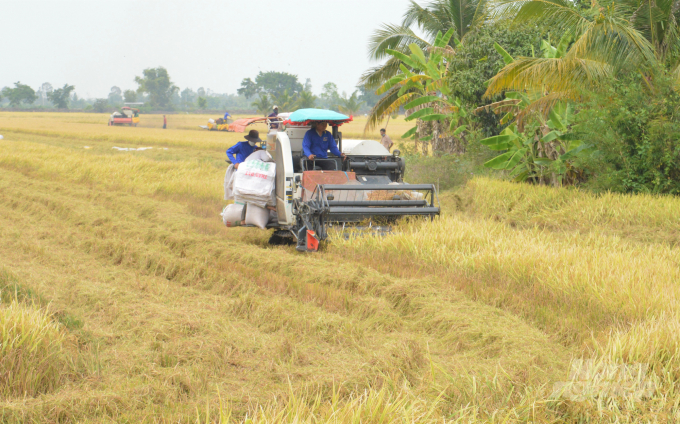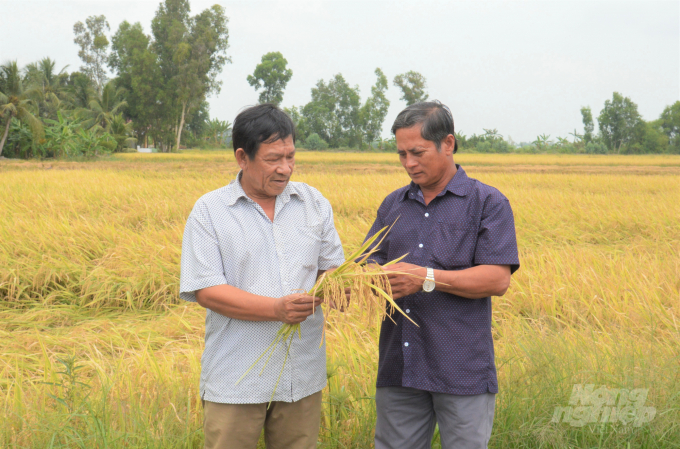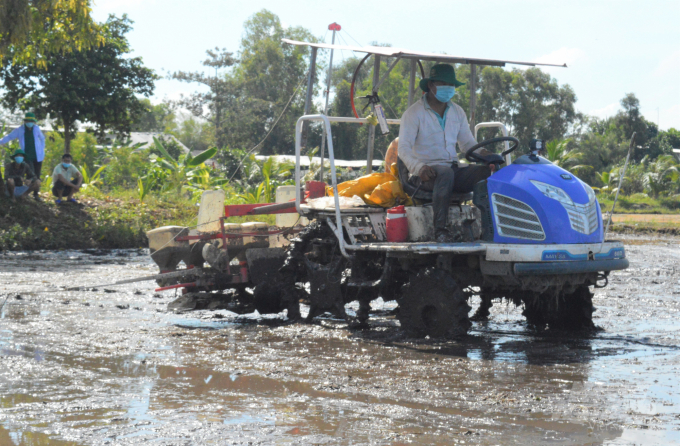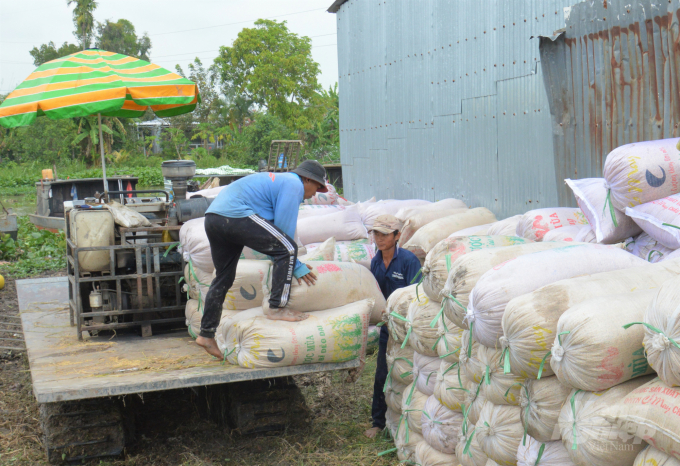May 20, 2025 | 12:55 GMT +7
May 20, 2025 | 12:55 GMT +7
Hotline: 0913.378.918
May 20, 2025 | 12:55 GMT +7
Hotline: 0913.378.918
Cuc Tuong commune (Chau Thanh district, Kien Giang), having over 3,200ha of rice land, are starting to harvest the 2021 - 2022 winter-spring rice crop. The smile of joy can be seen from all farmers thanks to this great crop. The members of Tan Tien Agricultural Cooperative are even happier when they work together to implement “Big paddy” in consideration of raw material area establishment and response to climate change.
The movement was sparked by Kien Giang Agricultural Extension Center, helping farmers reduce investment costs greatly and stabilize profits in the context of the skyrocket input prices.

Farmers implementing “Big paddy” in Kien Giang are entering the 2021 - 2022 winter-spring rice harvest. Photo: Trung Chanh.
"Upon implementing “Big paddy”, farmers receive rice cultivation training specifically the "1 must 5 decrease" techniques and keep the field diary so they have clear information about profit and loss right after harvesting is completed. According to my calculation, five expenditures have decreased significantly: Reducing the amount of rice seed sown saves VND 800,000; reducing fertilizers, mainly nitrogen fertilizers saves VND 570,000; reducing herbicides saves VND 215,000; reducing pesticide saves VND 716,000; other expenses such as labor saves VND 800,000,” said Ms. Thi Thuy, a member of Tan Tien Agricultural Cooperative.
To reduce costs, farmers do not burn the field after harvesting but bury the straw to self-decompose. They wait until the crop is ready, fix the ground, alum ditch and sow the winter-spring rice. Thanks to the relatively long interval between the two crops, organic poisoning is avoided. Thanks to implementing sparse transplanting with an amount of 100kg of rice seed/ha and below, the rice grows evenly and develops well without signs of diseases.

Chau Thanh farmers jointly implemented “Big paddy” with confidence stemming from the reality when the fields are healthy and bountiful even when the investment has been reduced. Photo: Trung Chanh.
Reducing the amount of chemical fertilizers and pesticides means reducing labor costs for farmers. This act also contributes to protecting the environment, ensuring better health, and producing cleaner products.
Production cost is reduced by VND 427/ kg of rice. The yield remains stable, resulting in an increase of more than VND 3.5 million/ha in profit. With an area of 70 ha, households within the influence of “Big paddy” earned an additional profit of nearly VND 250 million - a very meaningful figure in the reality of the constantly increasing production costs.
Mechanization needs to be further in sync
Mr. Hoang Trung Kien, Director of Kien Giang Agricultural Extension Center, said that in 2022 the unit implements a rice development program with a total area of more than 2,000 ha. The main activities include building large fields and applying synchronous mechanization with the aim of reducing investment costs effectively, reducing the amount of rice seed sown as well as fertilizers and pesticides. Some areas within the program execute networking of certified rice breeding and household rice breeding.

The cluster transplanting machine combines fertilizing right after sowing to help limit fertilizer loss while rice plants attain a better absorption rate, thereby saving costs for farmers. Photo: Trung Chanh.
According to Mr. Kien, the mechanization of all stages of rice production in Kien Giang province is quite high at present. Soil preparation, irrigation, and harvesting in the cultivated area reach the mechanization rate of 90-97%. Particularly, the caring stage such as sparse transplanting with a seed spreader and pesticide spraying with a mechanic sprayer is also quite common. The weakest stage is still the sowing stage as the machine use rate is still very low.

The program to develop rice through “Big paddy” in Kien Giang has gradually formed a concentrated production area to meet the requirements of consumption linkages and large output to meet export demand. Photo: Trung Chanh.
To overcome the weakness of mechanization in the sowing stage, Kien Giang Agricultural Extension Center is coordinating with Saigon Kim Hong Trading Service Co., Ltd. to bring the bush sowing machine into the program to develop rice in large fields.
"Korean-made bush sowing machine, in addition to saving rice seeds, also combines the function of burying fertilizer right after sowing, helping to limit fertilizer loss due to evaporation or washout, helping rice plants absorb fertilizer more effectively, saving costs for farmers.”
In addition, after the rice harvests, farmers implementing “Big paddy” are recommended to use Trichoderma fungus to treat rice straw, then plowing and burying to create natural organic fertilizers for the soil. This is a great method to reduce the amount of chemical fertilizers used. The benefit comes from returning organic matter to the soil, reducing organic poisoning for early-crop rice, and limiting field burning, smog pollution, and soil hardening phenomenon.
Regarding the gained results, “Big paddy” rice production areas in the 2021-2022 winter-spring crop in An Bien, U Minh Thuong and Vinh Thuan districts (Kien Giang), with a total area of 400ha, have relatively low production costs. The average reduction rate is VND 2,631/kg, down VND 439/kg compared to fields outside the program. The average investment cost for “Big paddy” rice crops is VND 16.5 million/ha.
Farmers choose to produce two varieties of rice in this crop, OM18 and Dai Thom 8. The highest selling prices at the time of harvest are VND 6,200 and 6,300 respectively for each kilogram of fresh rice harvested by machine.
The average profit of farmers is nearly VND 21 million/ha, of which the highest profit is VND 28 million/ha (“Big paddy” in Tay Yen A commune, U Minh Thuong commune) and the lowest is VND 15.3 million/ha (“Big paddy” in Binh Minh commune, Vinh Thuan).
Translated by Samuel Pham

(VAN) For years, the CRISPR-Cas9 genome technology has been reshaping genetic engineering, a precision tool to transform everything from agriculture to medicine.

(VAN) Vietnam aims to become a 'leader' in the region in the capacity and managing effectively soil health and crop nutrition.
![Reducing emissions from rice fields: [Part 1] Farming clean rice together](https://t.ex-cdn.com/nongnghiepmoitruong.vn/608w/files/news/2025/05/05/z6509661417740_a647202949c539012a959e841c03e1d3-nongnghiep-143611.jpg)
(VAN) Growing clean rice helps reduce environmental pollution while increasing income, allowing farmers to feel secure in production and remain committed to their fields for the long term.
/2025/05/19/5136-1-144800_230.jpg)
(VAN) The Nghe An Provincial People's Committee has just approved the list of beneficiaries eligible for revenue from the Emission Reductions Payment Agreement (ERPA) in the North Central region for the year 2025.

(VAN) 14 out of 35 domesticated elephants in Dak Lak province have had their living conditions improved, with 11 of them currently participating in the non-riding elephant tourism model.

(VAN) Muong Nhe Nature Reserve hopes that being upgraded to a national park will lay the foundation for forest protection efforts to be carried out in a systematic, modern, and sustainable manner.
/2025/05/16/3923-2-171845_52.jpg)
(VAN) Lower costs, higher yields, and improved soil quality are outstanding benefits that soybeans bring when integrated into the crop rotation system.